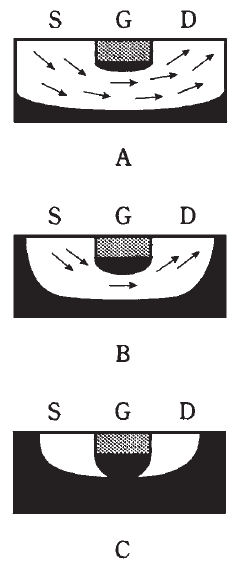


 الفيزياء الكلاسيكية
الفيزياء الكلاسيكية
 الكهربائية والمغناطيسية
الكهربائية والمغناطيسية
 علم البصريات
علم البصريات
 الفيزياء الحديثة
الفيزياء الحديثة
 النظرية النسبية
النظرية النسبية
 الفيزياء النووية
الفيزياء النووية
 فيزياء الحالة الصلبة
فيزياء الحالة الصلبة
 الليزر
الليزر
 علم الفلك
علم الفلك
 المجموعة الشمسية
المجموعة الشمسية
 الطاقة البديلة
الطاقة البديلة
 الفيزياء والعلوم الأخرى
الفيزياء والعلوم الأخرى
 مواضيع عامة في الفيزياء
مواضيع عامة في الفيزياء|
Read More
Date: 13-5-2021
Date: 13-4-2021
Date: 8-5-2021
|
Depletion and pinchoff
Either the N-channel or the P-channel JFET works because the voltage at the gate causes an electric field that interferes, more or less, with the flow of charge carriers along the channel. A simplified drawing of the situation for an N-channel device is shown in Fig. 1. For a P-channel device, just interchange polarity (minus/plus) and semiconductor types (N/P) in this discussion.
As the drain voltage ED increases, so does the drain current ID, up to a certain level-off value. This is true as long as the gate voltage EG is constant, and is not too large negatively.
But as EG becomes increasingly negative (Fig. 1A), a depletion region (solid black) begins to form in the channel. Charge carriers cannot flow in this region; they must pass through a narrowed channel. The more negative EG becomes, the wider the depletion region gets, as shown at B. Ultimately, if the gate becomes negative enough,

Fig. 1: At A, depletion region (solid area) is not wide, and many charge carriers (arrows) flow. At B, depletion region is wider, channel is narrower, and fewer carriers flow. At C, channel is completely obstructed, and no carriers flow.
the depletion region will completely obstruct the flow of charge carriers. This is called pinchoff, and is illustrated at C.
Again, think of the garden-hose analogy. More negative gate voltages, EG, correspond to stepping harder and harder on the hose. When pinchoff takes place, you’ve cut off the water flow entirely, perhaps by bearing down with all your weight on one foot! Biasing beyond pinchoff is something like loading yourself up with heavy weights as you balance on the hose, thereby shutting off the water flow with extra force.



|
|
|
|
دخلت غرفة فنسيت ماذا تريد من داخلها.. خبير يفسر الحالة
|
|
|
|
|
|
|
ثورة طبية.. ابتكار أصغر جهاز لتنظيم ضربات القلب في العالم
|
|
|
|
|
|
|
خلال ثلاث سنوات… مؤسسة وارث الدولية لعلاج الأورام تقدم العلاج المجاني لأكثر من (6500) طفل
|
|
|